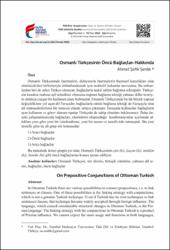| dc.contributor.author | Şenlik, Ahmet Şefik | |
| dc.date.accessioned | 2014-12-31T09:46:20Z | |
| dc.date.available | 2014-12-31T09:46:20Z | |
| dc.date.issued | 2014-12 | |
| dc.identifier.citation | ŞENLİK, Ahmet Şefik. "Osmanlı Türkçesinin Öncü Bağlaçları Hakkında." FSM İlmî Araştırmalar İnsan ve Toplum Bilimleri Dergisi, 4 (2014): 157-179. | en_US |
| dc.identifier.uri | http://dergi.fsm.edu.tr/index.php/ia/article/view/652/660 | |
| dc.identifier.uri | http://dergipark.ulakbim.gov.tr/fsmia/article/view/5000083936/5000078034 | |
| dc.identifier.uri | http://dx.doi.org/10.16947/fsmiad.78909 | |
| dc.identifier.uri | https://hdl.handle.net/11352/2148 | |
| dc.description.abstract | Osmanlı Türkçesinde önermeleri, dolayısıyla önermelerin biçimsel karşılıkları olan
cümle(cik)leri birbirleriyle irtibatlandırmak için muhtelif imkanlar mevcuttur. Bu imkanlardan
biri de aslen Türkçe olmayan, bağlaçlarla teşkil edilen bağlama tekniğidir. Türkçenin
kendine mahsus aslî teknikleri olmasına rağmen bağlama tekniği yabancı diller tesiriyle
oldukça yaygın bir kullanım alanı bulmuştur. Osmanlı Türkçesinde bu tür büyük yapısal
değişikliklere yol açan dil Farsçadır; bağlaçlarla cümle bağlama tekniği de Farsçayla olan
dil münasebetlerinin bir neticesi olarak ortaya çıkmıştır. Farsçada kullanılan bağlaçların
aynı kullanım ve görev alanına tıpatıp Türkçede de sahip olmaları beklenemez. Daha önceki
çalışmalarımızda bağlaçları, cümlelerin oluşturduğu kombinasyonlar içerisinde aldıkları
yere göre yeni bir isimlendirme, yeni bir tanım ve tasnife tabi tutmuştuk. Bu yeni
tasnifte göre üç alt grup söz konusudur:
1) Aracı bağlaçlar
2) Öncü bağlaçlar
3) Artçı bağlaçlar
Bu makalede ikinci grupta yer alan, Osmanlı Türkçesinin çūn (ki), ḳaçan (ki), mādām
(ki), hemān (ki) gibi öncü bağlaçlarına kısaca temas ediliyor. | en_US |
| dc.description.abstract | In Ottoman Turkish there are various possibilities to connect propositions, i.e. to link
sentences or clauses. One of these possibilities is the linking strategy with conjunctions,
which is not a genuine Turkish technique. Even if Turkish has its own techniques to link
sentences/clauses, that technique became widely accepted through foreign influence. The
language, which caused considerable structural changes in Ottoman Turkish, is the Persian
language. The linking strategy with the conjunctions in Ottoman Turkish is a product
of Persian influence. We cannot expect the same usage and functions in both languages, in Persian and in Ottoman Turkish. In our previous contributions we have suggested new
terms, new descriptions and a new classification made according the positions of conjunctions
in the combination of sentences. In this classification there are three subgroups
of conjunctions:
1) Interface conjunctions
2) Prepositive conjunctions
3) Postpositive conjunctions
In this paper we will deal with the second group, with the prepositive conjunctions of
Ottoman Turkish, like çūn (ki), qaçan (ki), mādām (ki), hemān (ki) etc. | en_US |
| dc.language.iso | eng | en_US |
| dc.publisher | FSM Vakıf Üniversitesi | en_US |
| dc.rights | info:eu-repo/semantics/openAccess | en_US |
| dc.subject | Osmanlı Türkçesi | en_US |
| dc.subject | Söz Dizimi | en_US |
| dc.subject | Birleşik Cümleler | en_US |
| dc.subject | Yabancı Dil Tesiri | en_US |
| dc.subject | Bağlaçlar | en_US |
| dc.subject | Öncü Bağlaçlar | en_US |
| dc.subject | Ottoman Turkish | en_US |
| dc.subject | Syntax | en_US |
| dc.subject | Complex Sentences | en_US |
| dc.subject | Conjunctions | en_US |
| dc.subject | Prepositive Conjunctions | en_US |
| dc.subject | Influence of Foreign Languages (Persian) on Turkish | en_US |
| dc.title | Osmanlı Türkçesinin Öncü Bağlaçları Hakkında | en_US |
| dc.title.alternative | On Prepositive Conjunctions of Ottoman Turkish | en_US |
| dc.type | article | en_US |
| dc.relation.publicationcategory | Makale - Ulusal - Editör Denetimli Dergi | en_US |



















